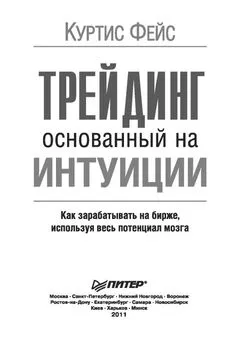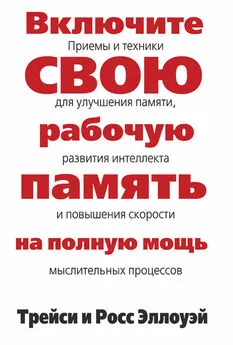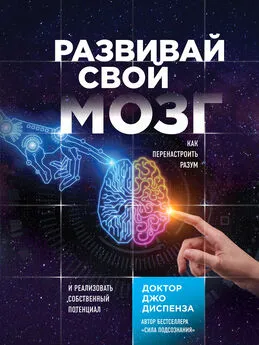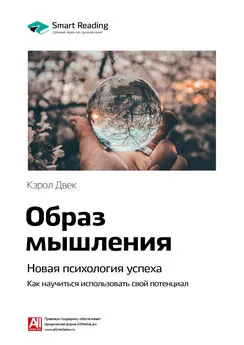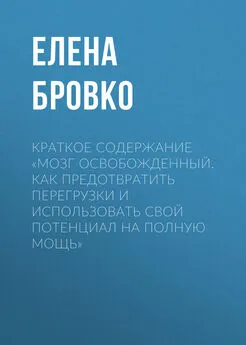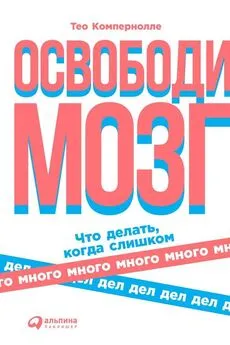Тео Компернолле - Мозг освобожденный. Как предотвратить перегрузки и использовать свой потенциал на полную мощь
- Название:Мозг освобожденный. Как предотвратить перегрузки и использовать свой потенциал на полную мощь
- Автор:
- Жанр:
- Издательство:Array Литагент «Альпина»
- Год:2015
- Город:Москва
- ISBN:978-5-9614-3976-1
- Рейтинг:
- Избранное:Добавить в избранное
-
Отзывы:
-
Ваша оценка:
Тео Компернолле - Мозг освобожденный. Как предотвратить перегрузки и использовать свой потенциал на полную мощь краткое содержание
Мозг освобожденный. Как предотвратить перегрузки и использовать свой потенциал на полную мощь - читать онлайн бесплатно полную версию (весь текст целиком)
Интервал:
Закладка:
212
Последние исследования показали, что в нашем головном мозге существует не один центр удовольствия, а комплекс из множества взаимосвязанных систем вознаграждения. Выяснилось также, что дофамин играет множество разных ролей. Кроме того, что он вызывает чувство удовольствия, он стимулирует активность, коммуникабельность, любопытство и стремление к поиску новизны.
213
The Machine Zone: This Is Where You Go When You Just Can’t Stop Looking at Pictures on Facebook.
What an anthropologist’s examination of Vegas slot machines reveals about the hours we spend on social networks ALEXIS C. MADRIGAL The Atlantic. Jul 31, 2013.
214
For Impatient Web Users, an Eye Blink Is Just Too Long to Wait. By STEVE LOHR The New York Times. Febr 29, 2012.
215
Predictability Modulates Human Brain Response to Reward. Gregory S. Berns, Samuel M. McClure, Giuseppe Pagnoni, and P. Read Montague. The Journal of Neuroscience, 15 April 2001, 21(8): 2793–2798.
216
The psychological roots of overconsumption. N. Hagens. in Fleeing Vesuvius.R. Douthwaite, G. Fallon and R. Heinberg p 339 (название этой статьи отчасти вводит в заблуждение, поскольку она содержит очень информативный материал о зависимостях).
Operant Sensation Seeking Engages Similar Neural Substrates to Operant Drug Seeking in C57 Mice. Christopher M. Olsen and Danny G. Winder. Neuropsychopharmacology. June 2009; 34(7): 1685–1694.
Neural Differentiation of Expected Reward and Risk in Human Subcortical Structures. Kerstin Preuschoff, Peter Bossaerts, and Steven R. Quartz. Neuron. Vol. 51, Issue 3, 3 Aug 2006, pp. 381–390.
The Neurobiology and Genetics of Impulse Control Disorders: Relationships to Drug Addictions. Judson A. Brewer, MD PhD and Marc N. Potenza, MD PhD Biochem Pharmacol. January 1, 2008; 75(1): 63–75.
Effects of dopamine depletion in reward seeking behavior. M. Pessiglione and L. Tremblay In Jean-Claude Dreher, Handbook of reward and decision making 2009 Elsevier Inc, p. 271.
217
Stress: Friend and Foe. Theo Compernolle. Synergo/Lannoo.
218
Influences of socioeconomic status, social network, and competence on subjective well-being in later life: A meta-analysis. Pinquart, Martin; Sӧrensen, Silvia. Psychology and Aging, Vol. 15(2), Jun 2000, pp. 187–224.
Stress, social support, and the buffering hypothesis.Cohen, Sheldon; Wills, Thomas A. Psychological Bulletin, Vol. 98(2), Sept 1985, pp. 310–357.
Sense of community belonging and health in Canada: A regional analysis. Kitchen, P., Williams, A., & Chowhan, J. (2012). Social indicators research, 107(1), pp. 103–126.
How Groups Affect Our Health and Well-Being: The Path from Theory to Policy. Jetten, J., Haslam, C., Haslam, S. A., Dingle, G., & Jones, J. M. (2014). Social Issues and Policy Review, 8(1), pp. 103–130.
Cross-cultural adaptation of Hispanic youth: a study of communication patterns, functional fitness, and psychological health. McKay-Semmler, K., & Kim, Y. Y. (2014). Communication Monographs, (ahead-of-print), 1–24.
A brief social-belonging intervention improves academic and health outcomes of minority students. Walton, G. M., & Cohen, G. L. (2011). Science, 331(6023), 1447–1451.
219
How does online social networking enhance life satisfaction? The relationships among online supportive interaction, affect, perceived social support, sense of community, and life satisfaction, Hyun Jung Oh, Elif Ozkaya, Robert LaRose, Computers in Human Behavior, Volume 30, Jan 2014, pp. 69–78.
220
Targeting college students on Facebook? How to stop wasting your money. Hemant Sashittala,Rajendran Sriramachandramurthyb,Monica Hodisa. Business Horizons, June 2012.
221
Envy on Facebook: A Hidden Threat to Users Facebook: Afaction? H. Krasnova, H. Wenninger, T. Widjaja and Peter Buxmann. 11th International Conference on Wirtschaftsinformatik, 27Febr – 1 March 2013, Leipzig, Germany. http://karynemlira.com/wp-content/uploads/2013/01/Envy-on-Facebook_A-Hidden-Threat-to-Users%E2%80%99-Life.pdf
Status Anxiety. Alain de Botton. 2004 Hamish Hamilton.
222
Cyberpsychology, Behavior, and Social Networking. Hui-Tzu Grace Chou and Nicholas Edge. February 2012, 15(2): pp. 117–121. doi:10.1089/cyber.2011.0324.
The Impact of Social Media on Children, Adolescents, and Clinical Report Gwenn Schurgin O’Keeffe, Kathleen Clarke-Pearson Pediatrics. March 28 2011 Pediatrics http://pediatrics.aappublications.org/content/early/2011/03/28/peds.2011–0054.full.pdf+html
223
Facebook Use Predicts Declines in Subjective Well-Being in Young Adults. Ethan Kross, Philippe Verduyn, Emre Demiralp, Jiyoung Park, David Seungjae Lee, Natalie Lin, Holly Shablack, John Jonides, Oscar Ybarra. 2013. PL oS ONE 8(8): e69841. doi:10.1371/journal.pone.0069841
224
The World Is Flat: A Brief History of the Twenty-First Century.Thomas Friedman; Farrar, Straus and Giroux, 2005.
225
Getting plugged in: An overview of Internet addiction. Caroline Flisher. Journal of Paediatrics and Child Health. Volume 46, Issue 10, Oct 2010, pp. 557–559.
226
Managing mobile multitasking: the culture of iPhones on stanford campus. Morgan G. Ames. CSCW '13 Proceedings of the 2013 conference on Computer supported cooperative work. pp. 1487–1498. http://delivery.acm.org/10.1145/2450000/2441945/p1487-ames.pdf?ip=137.56.81.143&id=2441945&acc=ACTIVE%20SERVICE&key=C2716FEBFA981EF1DADB8F2F3426481F339C1C9BAE845449&CFID=240362957&CFTOKEN=33442562&__acm__=1377108098_4a1290acc120374cec76d396a4b5397a
227
Why do I keep interrupting myself?: Еnvironment, habit and self-interruption. Laura Dabbish, Victor M. Gonzale, Gloria Mark. Proceedings of the 2011 annual conference on Human factors in computing systems. ACM New York, NY, USA, 2011.
On the need for attention-aware systems: Measuring effects of interruption on task performance, error rate, and affective state. Brian P. Bailey, Joseph A. Konstan. Computers in Human Behavior Volume 22, Issue 4, July 2006, pp. 685–708.
Reducing the disruptive effects of interruption: A cognitive framework for analysing the costs and benefits of intervention strategies. Deborah A. Boehm-Davis, Roger Remington Accident Analysis & Prevention. Volume 41, Issue 5, Sept 2009, pp. 1124–1129.
The effects of interruptions on task performance, annoyance, and anxiety in the user interface. Brian P. Bailey, Joseph A. Konstan, John V. Carlis. Proceedings of INTERACT (2001). Volume: 1, Publisher: Citeseer, pp. 593–601.
“Constant, constant, multi-tasking craziness constant, multi-taskingsher spheres. Victor M. Gonzale, Gloria Mark. Proceedings of the SIGCHI conference on Human factors in computing systems. ACM New York, NY, USA, 2004.
228
Corporate Brain Disorder. Theo Compernolle. 1999. Conference “The New Millennium” TIAS Business School. Tilburg. https://sites.google.com/site/compernolleconsulting3/books-tools-and-video-s/artcles-todownload
229
Multitasking. Buser, T., & Peter, N. (2012). Experimental Economics, 15, pp. 641–655.
230
DRIVER DISTRACTION IN COMMERCIAL VEHICLE OPERATIONS. Rebecca L. Olson, Richard J. Hanowski, Jeffrey S. Hickman, and Joseph Bocanegra. 2009. U.S. Department of Transportation. http://www.fmcsa.dot.gov/facts-research/research-technology/report/FMCSA-RRR -09-042.pdf
231
Hanging on the telephone: Mobile phone use patterns among UK-based business travellers on work-related journeys. Donald Hislop. Transportation Research Part F: Traffic Psychology and Behaviour. Volume 15, Issue 2, March 2012, pp. 101–110.
232
См., например: William Horrey ao., Ann Mccartt ao.
233
Time allocation and task juggling. D. Coviello, A. Ichino, N Persico – 2011. http://home.business.utah.edu/finmh/persico.pdf
234
The relation of strength of stimulus to rapidity of habit formation. R.M. Yerkes, J.D. Dodson. J Comp Neurol Psychol, 18 (1908), pp. 459–482.
Revolutionizing product development. Quantum leaps in speed, efficiency, andquality. Wheelwright, SC, Clark, KB, Free Press 1992/2011. P. 91.
Investigating the effects of computer mediated interruptions: An analysis of task characteristics and interruption frequency on financial performance. K. Asli Basoglu, Mark A. Fuller, John T. Sweeney. International Journal of Accounting Information Systems. Volume 10, Issue 4, Dec 2009, pp. 177–189.
Juggling on a high wire: Multitasking effects on performance. Rachel F. Adler, Raquel Benbunan-Fich. International Journal of Human-Computer Studies. Volume 70, Issue 2, February 2012, pp. 156–168.
235
Stress: Vriend en Vijand. Uitgeverij Lannoo Belgium. 2012. 14th edition.
236
Цитируется по моей книге «Стресс: Друг и враг» (Stress: Friend and Foe). Бесплатные материалы по этой книге можно найти на моем сайте www.compernolle.com
237
Stress: Vriend en Vijand. Uitgeverij Lannoo Belgium. 2012. 14th edition.
238
“A Pace Not Dictated by Electrons”: An Empirical Study of Work Without Email. Gloria J. Mark, Stephen Voida, Armand V. Cardello. Proceedings of CHI 2012.
239
The cost of interrupted work: more speed and stress. Gloria Mark. Proceedings of the twenty-sixth annual SIGCHI conference on Human factors in computing systems. ACM New York, NY, USA, 2008.
240
Switching on and off …: Does smartphone use obstruct the possibility to engage in recovery activities? Daantje Derksa, Lieke L. ten Brummelhuis, Dino Zecica & Arnold B. Bakker. European Journal of Work and Organizational Psychology. 23 Dec 2010.
241
Stress and open-office noise. Evans, Gary W.; Johnson, Dana. Journal of Applied Psychology, Vol. 85(5), Oct 2000, pp. 779–783.
242
Daily computer usage correlated with undergraduate students’ musculoskeletal symptoms. C.-H. Chang, B.C. Amick III, C.C. Menendez, J.N. Katz, P.W. Johnson, M. Robertson, J.T. Dennerlein. Am. J. Ind. Med., 50 (2007), pp. 481–488.
Undergraduate college students’ upper extremity symptoms and functional limitations related to computer use: a replication study. M. Jenkins, C.C. Menéndez, B.C. Amick III, J. Tullar, N. Hupert, M.M. Robertson, J.N. Katz Work, 28 (2007), pp. 231–238.
A prospective study of computer users: I. Study design and incidence of musculoskeletal symptoms and disorders. F. Gerr, M. Marcus, C. Ensor, D. Kleinbaum, S. Cohen, A. Edwards, E. Gentry, D.J. Ortiz, C. Monteilh. Am. J. Ind. Med., 41 (2002), pp. 221–235.
Читать дальшеИнтервал:
Закладка:

